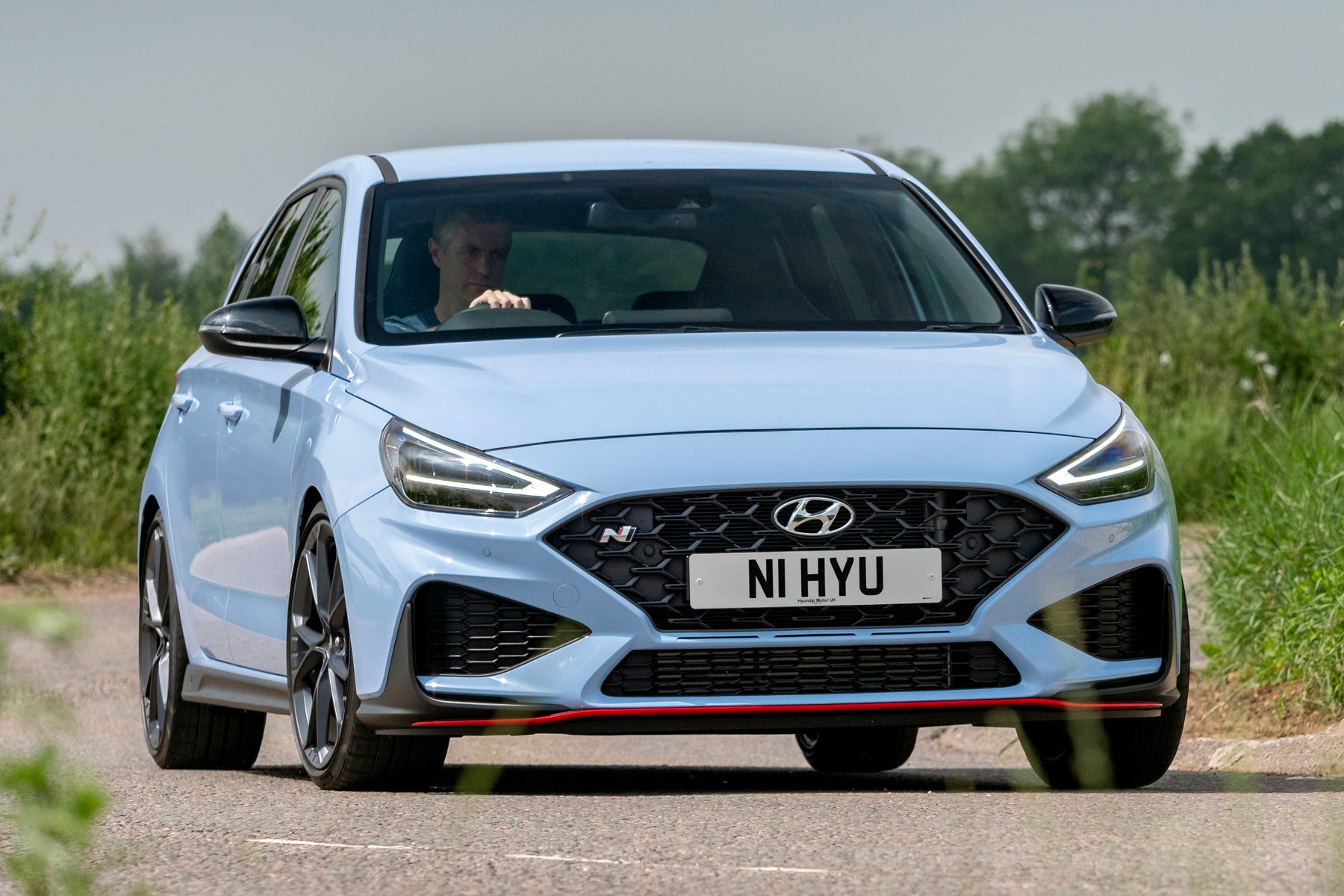Hyundai i30N Review 2025: Price, specs & boot space
Written by Ivan Aistrop
Quick overview
Pros
- Very fast and great fun
- Early versions reasonably priced
- Well equipped
Cons
- Prices have risen dramatically
- Ride will be too firm for some
- Not the most practical hot hatch
Overall verdict on the Hyundai i30N
"The Hyundai i30N isn’t the most dynamically polished car of its type, but it’s still enormously entertaining in an old-school, hardcore type of way. It’s also very convincing in a number of other areas, and that makes it a very impressive all-rounder, and it also looks like good value for money compared with rivals."
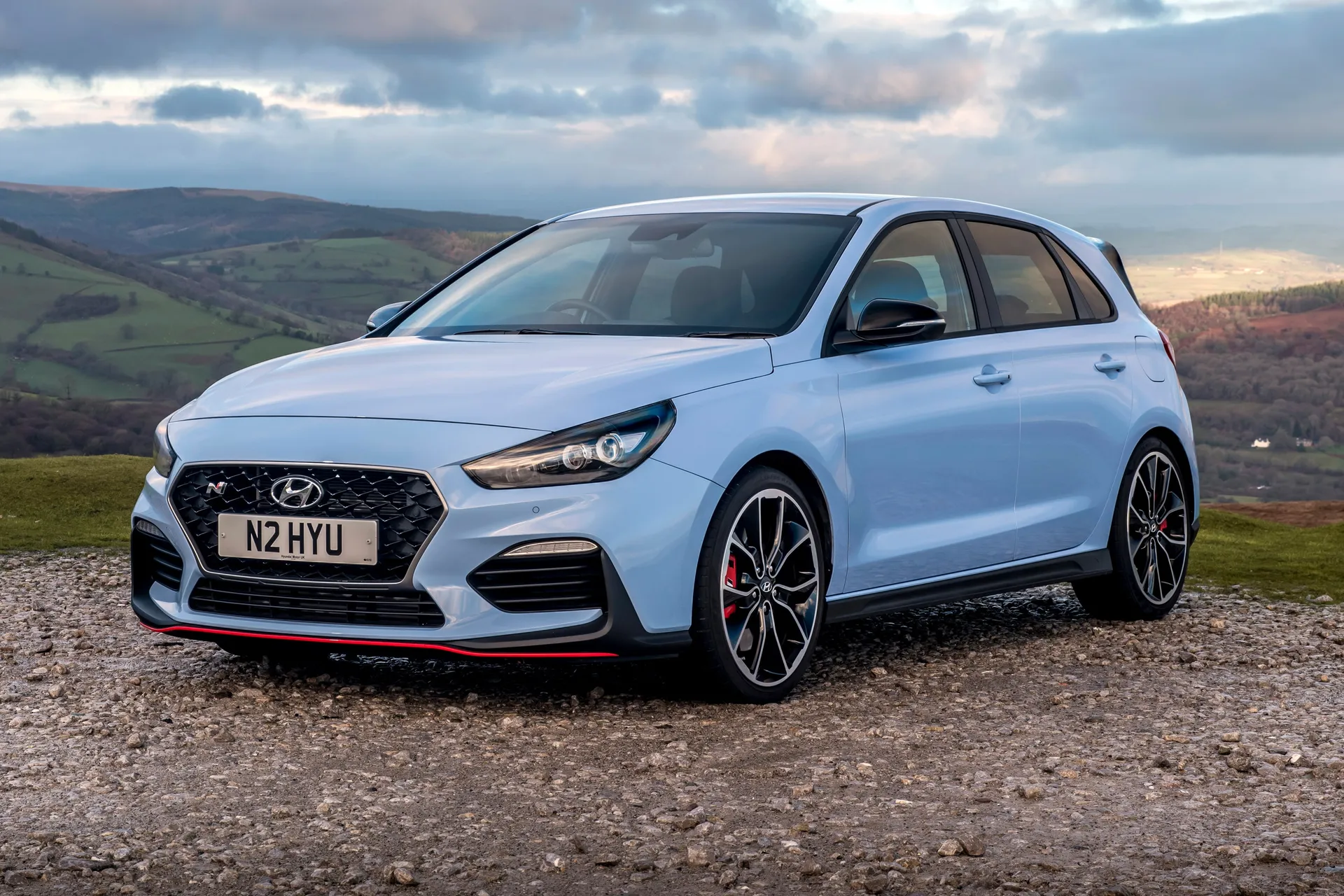
You have to hand it to the good folks at Hyundai: they don’t do things by halves. A few years back, when trying to establish the N Division, the new high-performance wing of the company, they didn’t bother going after the stragglers and also-rans in the hot hatch ranks. No sir, they decided to take on the car that’s been a hot-hatch icon for as long as anyone can remember: the all-conquering Volkswagen Golf GTI. Talk about ‘go big or go home’…
Indeed, that’s the sort of ambition that has taken this Korean manufacturing machine from figure-of-fun budget brand to serious mainstream player in the space of just a few short years, and it’s the reason why the firm now sits alongside long-established brands from Germany and Japan in terms of both status and sales figures.
But exactly how was this achieved? Well, in the case of the i30N specifically, with lots of dynamic technology: this car is packing not only a high-performance 2.0-litre turbocharged engine, but also launch control, automatic rev-matching, a variable exhaust system, a limited-slip differential, adaptive suspension, and various other bits of performance-enhancing gadgetry. It’s fair to say, then, that Hyundai threw the kitchen sink at this car.
And this tactic was successful, too. We should say at this point that the i30N isn’t the most dynamically polished car of its type: some rivals have more finesse and delicacy in the way they go about the business of stitching corners together, and getting through them as quickly as possible. It’s also true, however, that the Hyundai will match pretty much any of them for pace, and most importantly, for fun as well. It’s just a rather more old-school, brutal, hooligan-like brand of fun.
While there’s plenty to like about the way it drives, there’s plenty more to like about the i30N besides. First up, it’s keenly priced in comparison to rivals (although be aware that prices rose considerably after a facelift in 2021) and comes with a generous amount of standard kit, so it feels like good value for money. It may not be the roomiest or most practical car of its type, but it’s good enough to cope with the daily needs of a small family, and while it doesn’t feel as posh as some rivals, it is very solidly built. What’s more, Hyundai’s reputation for reliability, plus its super-generous five-year, unlimited-mileage warranty should make for trouble-free ownership.
So while the i30N may not lead the hot-hatch pack in any given area, it is very competitive in all of them, and that makes it a great all-rounder that’s very worthy of your consideration.
Looking for a used car for sale? We've got 100s of Hyundai Approved Used Cars for Sale for you to choose from, including a wide range of Hyundai i30N cars for sale.
Is the Hyundai i30N right for you?
If you want lots of performance, lots of equipment and a properly hardcore hot hatch attitude for a relatively affordable price, then the Hyundai i30N is most definitely right for you. It’s not the most dynamically polished car of its type, feeling rather more like a blunt instrument than a precision instrument, but it’s still great fun. What’s more, when compared with other hot hatch rivals, it’s very convincing in every single area, so it’s a cracking all-rounder, and it’s also cheaper than most, so looks like good value for money.
What’s the best Hyundai i30N model/engine to choose?
Since the 2021 facelift, there’s only been the one model to choose, because that’s when the entry-level version that was previously available was discontinued. If you’re considering a used version from before that, it’s the more powerful of the two that you want, the N Performance 275, because it’s faster and comes with more performance-enhancing kit. The good news is that these were way more popular as new cars, so are in far more plentiful supply than the entry-level N 250 on the used car market. If considering a later example, you’ll also have a choice of a manual or automatic gearbox, which you can read all about further down. Both are great, and have their own appealing factors, so it’s just a case of which you prefer.
What other cars are similar to the Hyundai i30N?
The Hyundai i30N is similar in size to hot hatches such as the Volkswagen Golf GTI/R and Cupra Leon, but rather different in other ways. Take the Golf for instance: the GTI is only a little more expensive but down on power, while the R is more comparable on power, but a lot more expensive, and the Hyundai also has a rather more hardcore attitude than both. In character, the N is probably most similar to the Honda Civic Type R, but that’s even more expensive still.
Comfort and design: Hyundai i30N interior
"The i30N doesn’t have the jazziest interior you’ll ever encounter, and it doesn’t exactly shift the needle for practicality, either, but it's roomy enough, and smart and solid enough, to convince as a proper, every-day family car."
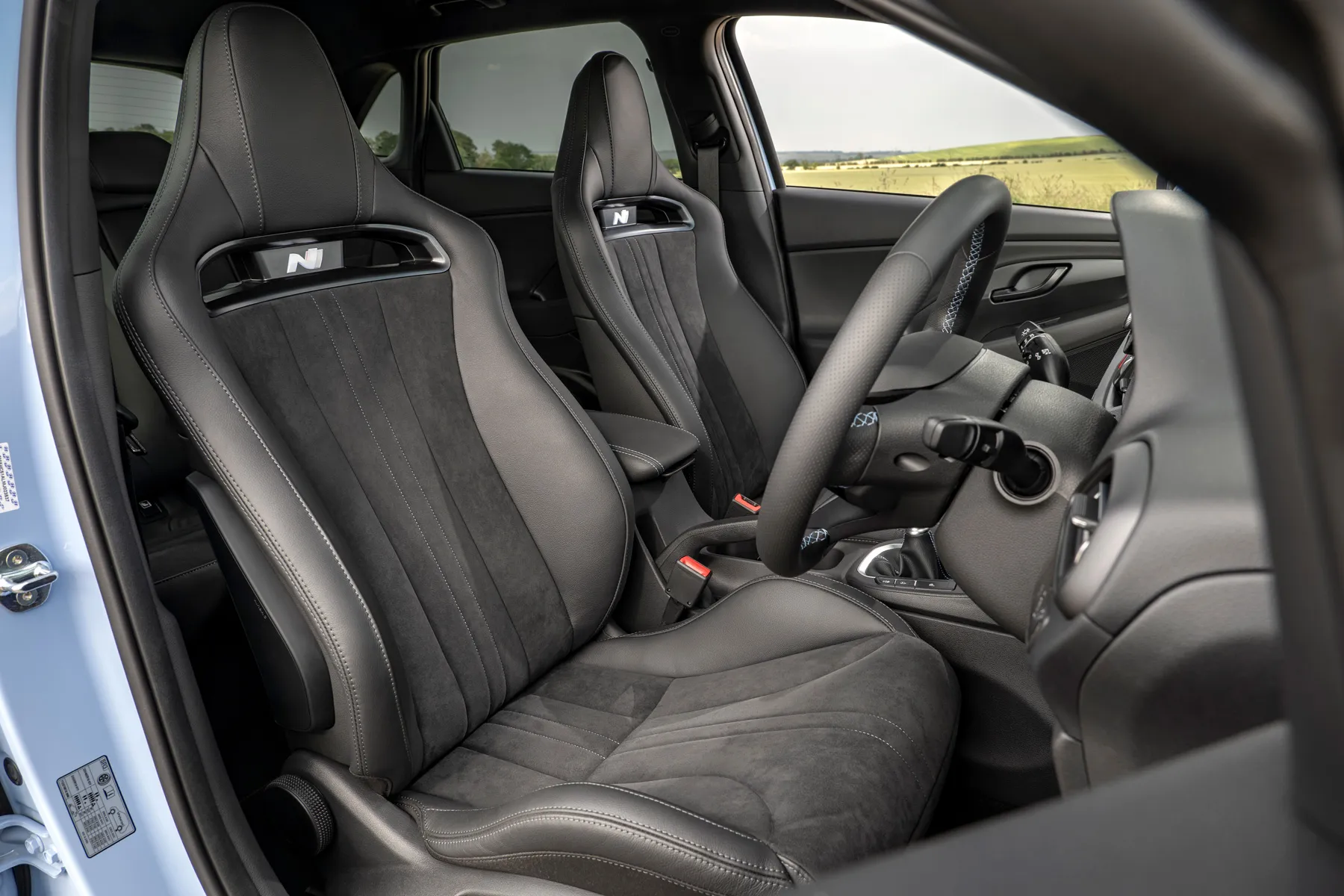
While far too many cars these days have a frustrating over reliance on touchscreen technology for operating their various functions, the i30N is refreshingly old-school in this area. Yes, a dashboard full of buttons, switches and dials may not look as clean or a fashionably minimalist as the dashboards in some rival cars, but it makes using the functions far easier, quicker and less distracting. All the controls sit where you expect to find them, too, so finding the one you want is nice and easy.
Finding a comfortable driving position is easy, too, because all but early N 250 cars come with electric adjustment for the front seats, complete with memory function (the version mentioned had manual adjusters), plus plentiful two-way movement in the steering column. Visibility is also pretty good at both ends of the car, with big windows and relatively slim pillars, but if you need more help with manoeuvring, all versions have front- and rear parking sensors and a reversing camera.
Quality and finish
Look around the interior of the i30N, and you don’t notice a great deal that marks it out from any other version of the i30. There are the two extra blue plastic buttons on the steering wheel - more on those later - and sports seats (on the early N 250 version, these were covered in fabric, but on 275 Performance and later 280 cars, they have a rather more pleasant man-made suede and leather finish), but that’s about it.
The so-so materials and dour colour scheme means that the cabin doesn’t feel as posh or as special as those in some rivals, which have considerably more pizzazz, but the i30N’s interior is still sturdily built and looks like it’ll stand the test of time extremely well.
Infotainment: Touchscreen, USB, nav and stereo in the Hyundai i30N
Early versions of the Hyundai i30N came with an 8.0-inch touchscreen, which had all the infotainment functionality you could want, including Bluetooth, DAB, built-in navigation, voice recognition, Android Auto and Apple CarPlay, and wireless phone charging. The system looked good and was reasonably easy to find your way around, so this on its own is no reason to avoid considering buying an earlier car if you find a good one.
However, tech-fans might want to consider a car from after the 2021 facelift, because this brought a slightly upgraded system. The level of functionality on offer was more or less the same, but it came with a swisher-looking 10.25-inch screen, allowing the on-screen icons to be marginally bigger for slightly easier use on the move, and the graphics and software were updated, so it looks a little slicker in that regard, too.
Space and practicality: Hyundai i30N boot space
One of the central attractions of a hot hatch is that it has enough space and versatility to deal with the boring bits of life when you have the family on board, as well as the ability to spice up your life when you don’t. And on the former point, the i30N does an entirely reasonable job.
Nobody will be left wanting for space in the front seats - as is the case with the vast majority of cars - while the rear seats have just about enough room to accommodate tall adults, with headroom being especially generous. In truth, there’s not as much legroom as in many rivals, so your passengers won’t be able to stretch out as much, but they should fit.
The boot is reasonable rather than exceptional for size: the 381 litres of capacity you get is more or less spot-on with what you get in a Volkswagen Golf GTI. However, there is a small load lip to negotiate when loading heavy items, and when you fold down the 60/40 split-folding rear seats, there’s a step between the load floor and the folded seatbacks. Sitting above that step in the boot is a structural brace that improves the car’s torsional rigidity to improve cornering ability, and this will get in your way even more.
Handling and ride quality: What is the Hyundai i30N like to drive?
"The i30N isn’t the most dynamically polished hot hatch of its type, and the firm suspension requires you to make certain compromises in comfort. However, while it doesn’t lead the way in any single area, it’s extremely convincing in all of them, which makes it a great all-rounder and terrific fun."

In order to compete with more established hot hatch models from more established hot hatch manufacturers, Hyundai threw a wide variety of performance-enhancing gadgetry at the i30N. All versions come with an adaptive suspension, launch control and an automatic rev-matching function that blips the throttle on downshifts, while higher-powered Performance models also get a variable exhaust, upgraded brakes and an electronically actuated mechanical limited slip differential.
Many of these variables - along with others such as the steering, throttle response, transmission mapping - are governed by which driving mode is selected at any given time, dialling the severity of their behaviour up or down accordingly. For example, select Normal mode, and you’ll find the steering relatively light, the exhaust relatively quiet, the automatic gearshifts (where that option is fitted) nice and smooth, and the suspension relatively supple, although even in the softest setting, there’s still a distinctly firm edge to the ride that never quite goes away. And in this state, the i30N is a car that can deal with the daily grind in an easy, fuss-free and (just about) comfortable enough manner.
However, punch in N mode with one of the buttons on the steering wheel, and all hell breaks loose. The steering gets much weightier, the automatic gearbox (again, where fitted) keeps the revs sky-high and punches through the ratios more quickly and with more clout, the exhaust spits and crackles, and the suspension hunkers down to its firmest setting. In truth, this firmest setting is way too much for the public road, and should only be used for racetracks. Happily, there’s a Custom mode that allows you to specify the severity of each parameter yourself.
Yes, with five driving modes to choose from, there are various stages of severity in between the two extremes, but it’s this Jekyll-and-Hyde duality that makes the car as fascinating to drive as it is entertaining.
But although the driving mode you select changes the attitude and character of the car unrecognisably, it truth, it goes around corners incredibly well whichever you choose. Grip is mighty, the diff does a great job of helping you get the power down coming out of bends, and the body stays flat and composed at all times. The steering isn’t the most feelsome setup you’ll ever encounter, and the handling doesn’t have the nuanced deftness of touch that some rivals deliver, making the N feel like more of a blunt instrument, but there’s no doubting the pace and precision with which it gets from point to point, or the amount of fun you’ll have getting there.
What engines and gearboxes are available in the Hyundai i30N?
All versions of the i30N have a turbocharged 2.0-litre four-cylinder petrol engine, but there is some variation within that. Early cars came in two flavours, the standard N 250, which delivered a power output of 250PS, and the N Performance 275, which hiked the output to 275PS. Both came with a six-speed manual gearbox and a launch control function.
Engage that function, and the 250 would complete the 0-62mph sprint in 6.4 seconds, while the 275 would trim that to 6.1 seconds. Both were very fast, then, but although the difference between the two figures doesn’t seem like a lot on paper, there was an appreciable difference in the sensation of acceleration that the two versions delivered. Okay, so you were never going to feel like you’re short of go in the 250, but the 275 did feel like it had an additional level of zip, both away from the line and when picking up speed on the move.
A facelift of the car in 2021 changed things. The 250 was dropped because it didn’t sell anywhere near as well as its more powerful sibling, and the power level of the Performance version was hiked by a further 5PS to 280PS. The six-speed manual gearbox was still offered, but it was joined in the range by a new eight-speed dual clutch automatic transmission.
Engage launch control once again, and the sprint time of the manual version was trimmed down to 5.9 seconds. That was trimmed even further by the automatic version, which could conduct the same dash in just 5.4 seconds.
Yes, both deliver a sense of searing, brutal acceleration that is pretty intoxicating, but they do it in slightly different ways. Stirring the manual gearshift as you rifle through the ratios undeniably adds a level of involvement and engagement in the manual version that’s missing from the automatic, but the automatic’s extra pace and sensation of more unbroken acceleration is very appealing in itself.
The auto also has a few other tricks up its sleeve to help persuade you to spend the extra. These include the ludicrously named N Grin Shift function. Push a button on the steering wheel and floor the throttle, and the operation of the engine and gearbox is maximised to provide a boost of acceleration for 20 seconds. On hitting the button, the gearbox immediately shifts down to exactly the right ratio to give you maximum performance. And once the boost is done and dusted, you can't use the function again for another 40 seconds. Sure, it’s a bit of a gimmick, but it is fun nonetheless.
Both gearboxes are great, to be honest, so which you pick will kind of just depend on which approach you prefer.
Refinement and noise levels
With the exception of the early N 250 entry-level models, all i30Ns come with an active variable exhaust. This changes its behaviour according to which of the various driving modes you select, making things quieter in the more laid-back modes, and considerably more bombastic in the lairier modes. And it’s very effective. The engine is never what you’d call quiet in the relaxed modes, but it does settle into the background to an acceptable degree, while in the racier modes, the car becomes and absolute howling monster, the exhaust bellowing loudly as the revs rise, and spitting and popping as you lift off the accelerator for maximum theatrics.
The broad tyres do kick up a bit of road noise at the motorway limit, but not to a troublesome degree, while wind noise is also reasonably well contained. Again, the operation of the automatic gearbox depends on which driving mode is selected. It swaps ratios smoothly and cleanly in the relaxed modes, while in the sportiest ones, it punches through them a lot more quickly and aggressively.
Safety equipment: How safe is the Hyundai i30N?
Regardless of age or version, all i30Ns come with the same level of safety kit, and it’s reasonably good. The standard roster includes various systems to stop you driving into things in the first place, such as forward collision warning with automatic emergency braking, driver attention alert, lane departure warning, lane keep assist, and all the usual electronic traction and stability management systems. If for some reason you still manage to collide with something, measures to help keep you and your passengers from harm include six airbags and Isofix child seat mounting points on the outer rear seats.
At this money, it’s perhaps a little surprising that you don’t get adaptive cruise control with the various autonomous driving aids that are becoming more and more commonplace throughout the car industry, but this isn’t a deal-breaker.
The i30 hatchback was crash-tested by Euro NCAP in 2017, and achieved the full five-star rating. That rating applies to all versions of the i30, the N included, but because the test was done so long ago and the testing standards become more stringent annually, it’s likely that the car wouldn’t score quite so well if it were tested now.
MPG and fuel costs: What does a Hyundai i30N cost to run?
"The Hyundai i30N doesn’t have the greatest fuel economy in the world, either on paper or in the real world, but it should be fairly competitive with other running costs. In particular, the tremendous warranty package you get as standard will make you feel very smug indeed."
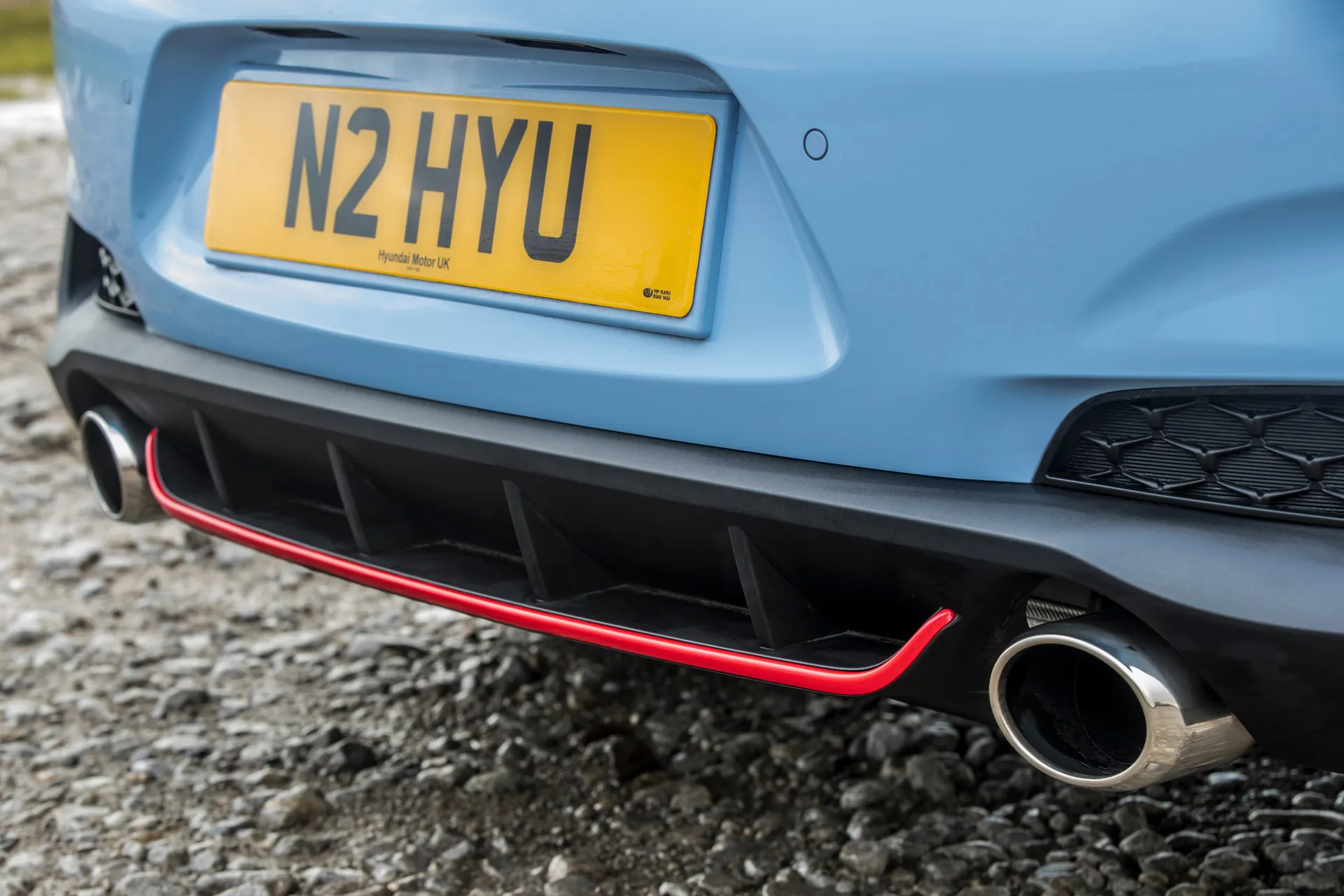
In early versions of the i30N, the official fuel economy was given at around 40mpg. It was just above that threshold for the N 250 version, and just below it for the N 275 Performance version. After the facelift happened and the two earlier versions were replaced by the 280, the official figures were worse, at just upwards of 35mpg for the manual, and just upwards of 33mpg for the automatic, despite its extra gears. However, we’re pretty sure that’s more to do with the switch from the NEDC testing standard to the more representative WLTP testing standard, rather than there being that much of a difference in actual fuel consumption.
Of course, these laboratory-collated figures - regardless of the testing standard used - are fairly useless for reflecting what you’ll get in real-world use, and getting anywhere near them would require driving your i30N like a modern-day saint. Which, of course, you won’t, and if you did, there’d be no point having an i30N in the first place. It’s best just to ignore the figures, drive the car like you want to drive it, and just make your peace with the fact that you’ll probably spend quite a few quid on fuel.
How reliable is the Hyundai i30N?
If nothing else, you can take plenty of comfort from knowing that all Hyundais - even high-performance N ones - are covered by the same five-year, unlimited-mileage warranty, which is one of the most generous arrangements in the industry. Not only does that give you the luxury of five years of worry-free motoring, it also hints at Hyundai’s confidence in the mechanical durability of its cars.
That confidence is well-founded, too, because the Korean firm’s reputation for reliability is very impressive. Out of the 29 manufacturers considered in the most recent HonestJohn.co.uk Satisfaction Index, Hyundai was rated as the 7th best brand for overall customer satisfaction, and 9th best for reliability specifically. That's not a fluke, either, because most of the other reliability surveys doing the rounds place Hyundai in a similar position.
Insurance groups and costs
Regardless of which powertrain your i30N has - 250PS, 275PS or 280PS - it will sit in insurance group 27 out of 50, so although premiums won’t be cheap, they shouldn’t be too steep, either. The VW Golf GTI sits in group 28, so is fairly similar, but what’s perhaps more surprising is that the smaller Hyundai i20N hot hatch, which has just 204PS, sits in exactly the same insurance group as the bigger, more powerful i30N.
VED car tax: What is the annual road tax on a Hyundai i30N?
Because all i30Ns were built after 2017, all examples are subject to the latest tax regulations, which command a flat rate of £180 per year from all petrol and diesel cars without hybrid technology. Cars that cost over £40,000 when brand new, including any optional extras fitted, are also subject to an additional annual surcharge of £380 between years two and six of the car’s life. While the prices of early cars were nowhere near that, regular price rises have seen the latest examples get a lot closer. With very few optional extras available, it’s unlikely that enough would be fitted to take the price of a late example over the threshold, but it would still be worth doing an online check with the registration number of any potential purchase just to make sure what the tax liability might be.
How much should you be paying for a used Hyundai i30N?
"Because the i30N has been around for a good slice of time, and hasn’t changed all that much, you can pick up a car that feels nearly new for significantly less than you’ll pay for a new one."
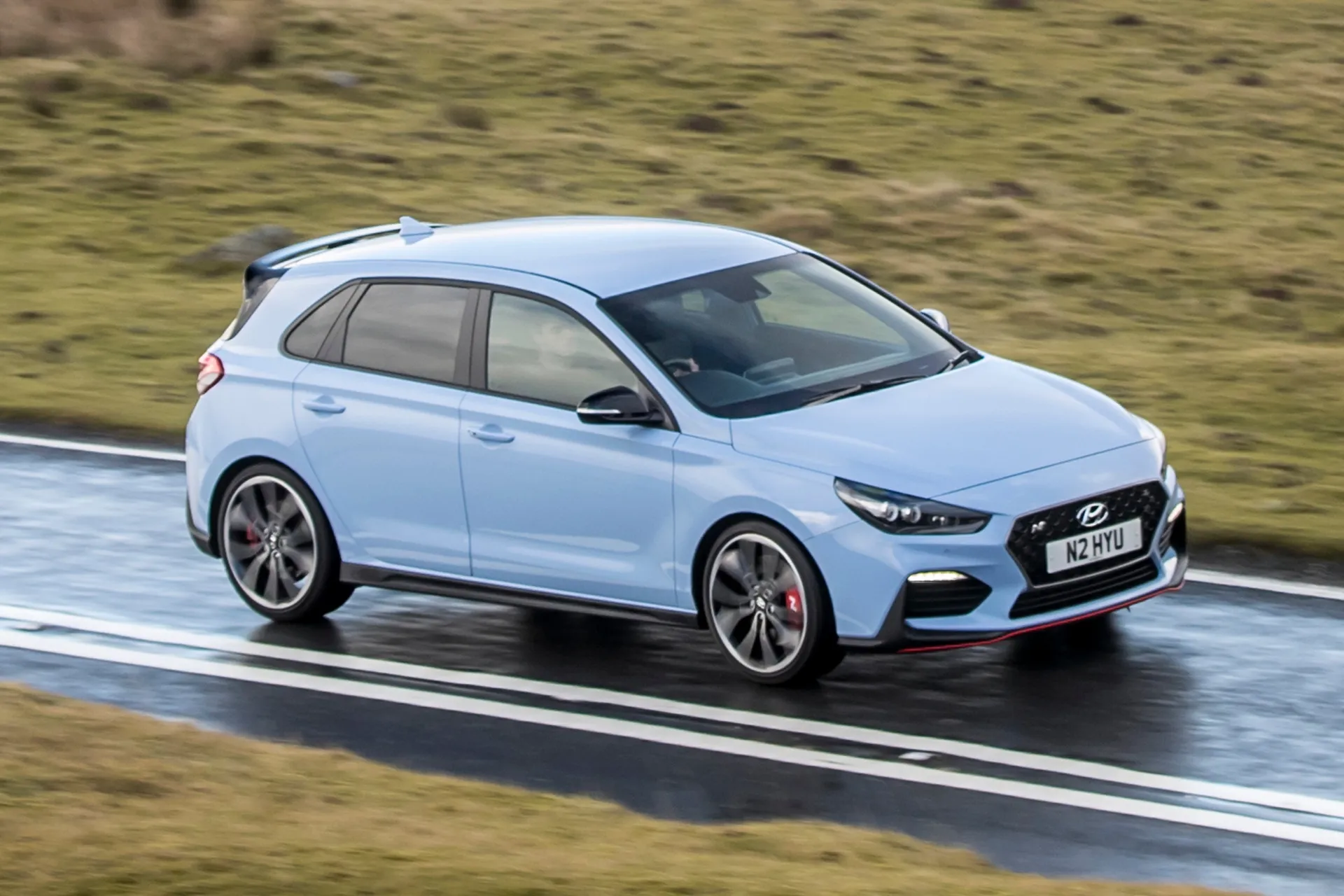
The price of a brand new Hyundai i30N has varied massively during its time on sale, due to various incremental price rises over the years, plus a big jump of several thousand pounds around the time of the 2021 facelift. When it first went on sale, both versions started at less than £30,000, but these days, a brand new one will cost you closer to £40,000.
This also means quite a spread on used examples, but there are some bargains to be had on the used market. The vast majority of examples you’ll find in our listings are the higher-powered N Performance versions, and there are numerous cars from 2018 and 2019, with around 30,000 miles on the clock, sitting at around the twenty grand mark, representing a very useful saving.
Trim levels and standard equipment
As we’ve said, the i30N was available in two forms when it first came out in 2018, the regular N 250 and the N Performance 275. As well as the difference in power output, there was also a difference in the amount of equipment provided, albeit marginal.
The basic car came with 18-inch alloy wheels, cloth upholstery, automatic lights and wipers, climate control, all-round LED lighting, privacy glass, power folding and adjusting door mirrors, front- and rear parking sensors, a reversing camera, cruise control, and keyless entry and go, alongside all the other performance, safety and infotainment kit we’ve already mentioned.
The Performance version added some extra bits of performance-enhancing equipment such as an active variable exhaust, upgraded brakes and a limited slip differential, plus bigger 19-inch alloy wheels, and it also added some extra luxury niceties including electric front seat adjustment with memory, and man-made suede and leather upholstery.
When the car was facelifted in 2021, the entry-level model was discontinued, so all versions came with the higher-grade equipment specification.
Ask the heycar experts: common questions
Is the Hyundai i30N fast?
How much is a Hyundai i30N?
Is the Hyundai i30N a good hot hatch?
Get our latest advice, news and offers
Keep me updated by email with the latest advice, news and offers from heycar.
By submitting you agree to our privacy policy
